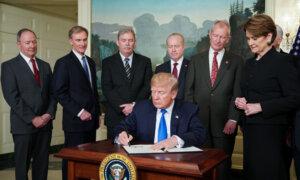The nonpartisan agency’s analysis examines three possible scenarios under Trump’s proposed tariffs.
Proposed tariff hikes by President-elect Donald Trump could significantly reduce the federal deficit over the next decade and would do so at modest cost to inflation and economic output, according to a new Congressional Budget Office (CBO) analysis, which is the highest-profile impact assessment yet of Trump’s proposed tariffs.
The agency warned that the proposed tariffs also have downsides. Inflation, as measured by the Personal Consumption Expenditures (PCE) price index, an inflation gauge that the Federal Reserve relies on most heavily in setting monetary policy, would increase by 1 percent over the next two years under the combined scenario.
After 2026, the tariffs would not have any additional significant effects on prices. Economic output would also see a decline. Under the most aggressive tariff scenario, U.S. gross domestic product (GDP) growth would be a relatively modest 0.6 percent lower over the next 10 years than it otherwise would be.
Supporters of Trump’s proposed tariffs contend that the long-term benefits of strengthened domestic production capabilities and reduced dependence on foreign imports justify the short-term economic costs.
Critics say that the economic drawbacks may outweigh the benefits. Some economists warn that higher tariffs could disrupt global supply chains, leading to inefficiencies and higher production costs for U.S. businesses. There are also concerns about potential retaliatory measures from trading partners, which could harm U.S. exporters and further dampen economic growth.
Other Scenarios
The CBO also analyzed the potential impacts of Trump’s proposed tariffs under two narrower scenarios: a universal 10 percent tariff on all imports and a 60 percent tariff on Chinese imports only. Both scenarios would reduce the federal deficit, with varying effects on inflation and economic growth.
Under the universal 10 percent tariff scenario, the CBO estimates a deficit reduction of $2.2 trillion over the next decade, contributing to a nearly 10 percent reduction of the projected $22.1 trillion cumulative deficit. Inflation would rise by 0.6 percent through 2026, with no additional meaningful impact on prices thereafter. The economic impact would also be less severe than in the combined scenario, with GDP growth slowing by only 0.3 percent over 10 years.
The 60 percent tariff on Chinese imports would yield a smaller deficit reduction of $0.8 trillion over the same period, largely due to its narrower overall scope. Inflation would increase by 0.4 percent over the next two years, while GDP growth would decline by 0.3 percent over the decade.
Tariffs as Leverage
Some analysts and individuals in Trump’s orbit have suggested that the president-elect’s aggressive tariff proposals may be more about leverage than revenue.
“Whether it is getting allies to spend more on their own defense, opening foreign markets to U.S. exports, securing cooperation on ending illegal immigration and interdicting fentanyl trafficking, or deterring military aggression, tariffs can play a central role,” he wrote.
“In other words,@realDonaldTrump is going to use tariffs as a weapon to achieve economic and political outcomes which are in the best interest of America, fulfilling his America first policy.”
Original News Source Link – Epoch Times
Running For Office? Conservative Campaign Consulting – Election Day Strategies!


